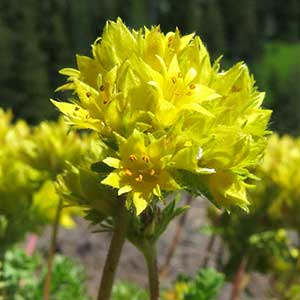Ivesia gordonii
Ivesia pygmaea
alpine ivesia, alpine mousetail, Gordon's ivesia
dwarf ivesia, dwarf mousetail
prostrate to erect, (0.2–)0.5–4 dm.
decumbent to erect, 0.3–1(–1.5) dm.
tightly to loosely cylindric, (1–)3–20(–25) cm; sheathing base ± glandular abaxially, otherwise glabrous;
petiole 0.5–8 cm, hairs 0.2–0.5 mm;
leaflets (6–)10–25 per side, (1–)2–13(–18) mm, glabrous or ± hirsute or villous, glandular-puberulent or -pubescent, lobes (2–)4–8(–15), linear or narrowly oblanceolate to obovate, apex rarely setose.
tightly cylindric, (0.5–)1–8(–12) cm; sheathing base usually ± strigose abaxially;
petiole 0.5–4 cm, hairs 0.2–1 mm;
leaflets 10–15(–20) per side, 0.5–4(–5) mm, sparsely to moderately short-villous, densely glandular, lobes 3–6(–8), oblanceolate to narrowly oblong or oval, apex setose.
1(–2), not paired.
(0–)1, not paired.
5–50(–70)-flowered, 1–8(–11) cm diam.;
glomerules 1–several.
(1–)5–10-flowered, 0.8–3 cm diam.;
glomerules usually 1.
1–3(–5) mm.
1.5–8(–10) mm.
5–12 mm diam.;
epicalyx bractlets linear to narrowly elliptic, (0.5–)1–3.5(–4) mm;
hypanthium turbinate to campanulate, (1.5–)2–4(–4.5) × 2–4(–5) mm;
sepals (2–)2.5–5(–6) mm, obtuse to ± acute;
petals yellow, narrowly oblanceolate to narrowly spatulate, (1–)1.5–3 mm;
stamens 5, filaments 1.3–2.5 mm, anthers yellow, sometimes red-margined, 0.5–1 mm;
carpels (1–)2–4(–6), styles 2.5–4.5(–6) mm.
9–11 mm diam.;
epicalyx bractlets elliptic to oblong, 1.2–2 mm;
hypanthium shallowly cupulate, 1–2 × 2.5–5(–7) mm;
sepals 2–3.5 mm, bluntly acute;
petals golden yellow, broadly oblanceolate to spatulate or broadly obovate, (2–)2.5–3.5(–4) mm;
stamens 10, filaments 0.6–1.8 mm, anthers yellow, 0.6–0.8 mm;
carpels 10–30, styles 0.9–1.3 mm.
grayish brown to mottled brown, ± 2 mm.
greenish tan to light brown, 1.2–1.5 mm.
Ivesia gordonii
Ivesia pygmaea
Varieties 4 (4 in the flora).
Ivesia gordonii is the most widespread species of the genus, occurring from Washington to Montana, south to central California and Colorado. The species can be distinguished from other members of sect. Ivesia by the relatively deep hypanthium, which is about as deep as wide. Four varieties are provisionally recognized here (B. Ertter and J. L. Reveal 2007), with the likelihood that future work may indicate additional and/or alternate circumscriptions. Populations that are difficult to assign to a variety can be found where the recognizable taxonomic units come together, for example, in northeastern Utah and western Wyoming, involving var. gordonii and var. wasatchensis, and in California and central Idaho where var. alpicola and var. ursinorum tend to merge.
(Discussion copyrighted by Flora of North America; reprinted with permission.)
Ivesia pygmaea is known only from the southern Sierra Nevada in California, where it overlaps the range of I. lycopodioides var. megalopetala. Stamen number is the only unequivocal way to distinguish between the two, though I. pygmaea is also more generally setose with somewhat shallower hypanthia. It is also more likely to have much-branched caudices and can form mats in rocky sites. Larger plants with relatively open cymes have sometime been segregated as I. chaetophora; this probably represents ecological and phenotypic plasticity.
Early reports of Ivesia pygmaea from Nevada are based on P. A. Rydberg’s (1898) mistaken understanding of the type locality, which is actually in Tulare County, California. A reported occurrence from the northern Sierra Nevada in Nevada (J. T. Kartesz 1987) is presumably based on the same source as the unconfirmed report of I. lycopodioides from the same locality (D. D. Keck 1938).
The correct name for this species if treated as Potentilla is P. nubigena Greene; P. decipiens Greene is a later homonym and illegitimate.
(Discussion copyrighted by Flora of North America; reprinted with permission.)
1. Leaflets 7–13(–18) mm, glabrous or sparsely hirsute or villous marginally; stems (1–)1.5–4 dm; inflorescences usually branched, 2–8(–11) cm diam., glomerules (1–)2–6(–10), ± capitate. | var. wasatchensis |
1. Leaflets (1–)2–7(–9) mm, hairy or ± glabrous except marginally ciliate; stems (0.2–)0.5–2.5 dm; inflorescences simple or branched, 1–3(–5) cm diam., glomerules 1(–3), ± capitate to loosely congested | → 2 |
2. Stems usually prostrate to ascending, rarely nearly erect, usually dark reddish, minutely glandular or glandular-puberulent to -pubescent; leaves to 0.8 cm diam.; anthers usually red-margined. | var. ursinorum |
2. Stems usually ascending to erect, sometimes decumbent, usually greenish, rarely reddish, hirsute to villous, glandular-puberulent to -pubescent; leaves to 1.5 cm diam.; anthers rarely red-margined | → 3 |
3. Stems usually hirsute to villous, sometimes densely so, glandular-pubescent or eglandular; basal leaves (3–)5–10(–15) cm; flowers 7–12 mm diam.; e Idaho and w Montana to Utah, Wyoming, and w Colorado. | var. gordonii |
3. Stems not or sparsely hirsute to villous, glandular-puberulent or -pubescent; basal leaves 2–8(–10) cm; flowers 5–9 mm diam.; s Washington to California and e to w Montana. | var. alpicola |


